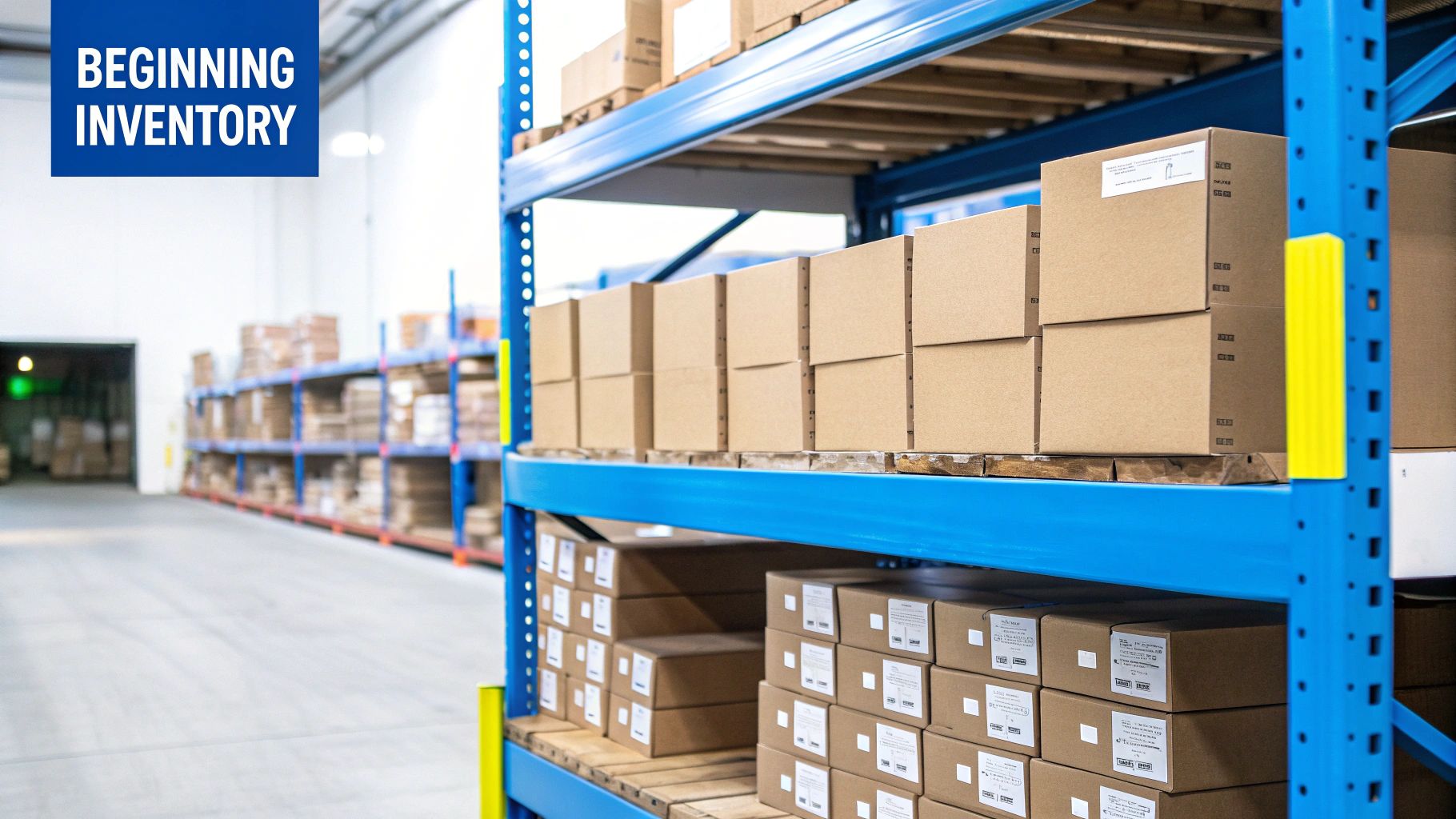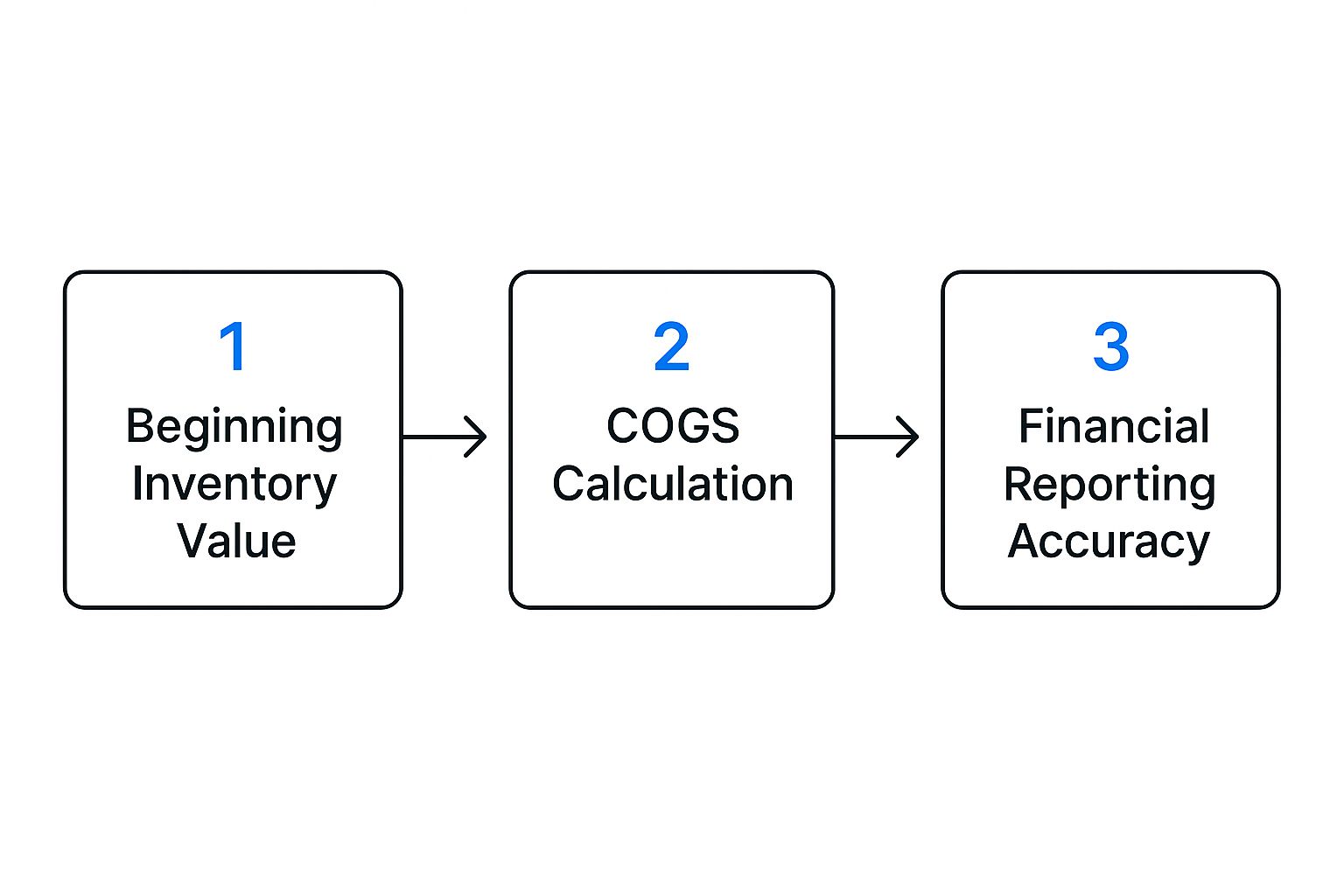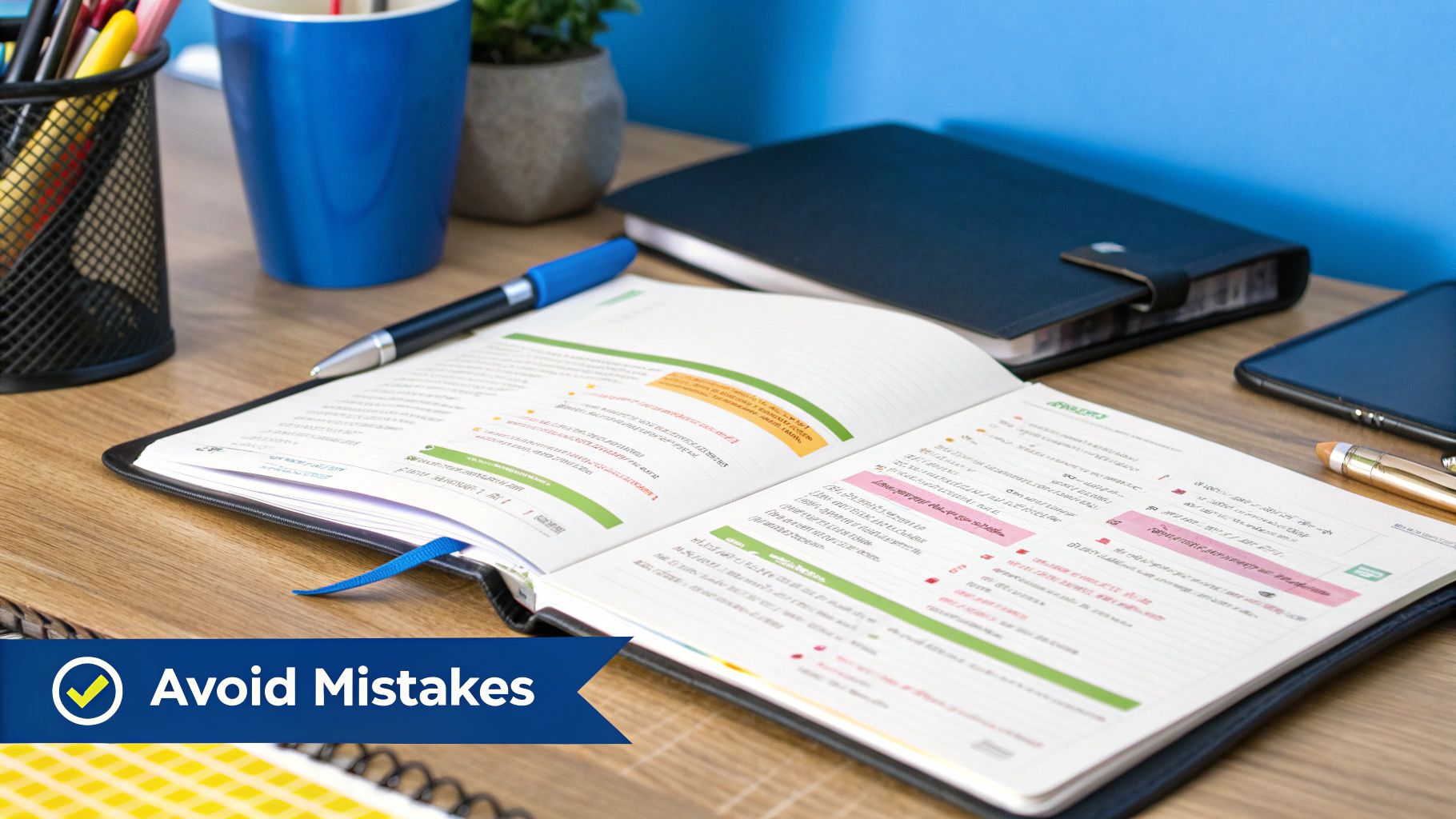To figure out your beginning inventory, you're essentially working backward. You need to take the inventory you had left at the end of the last period, factor in what you sold, and account for what you bought. It’s a simple calculation that reverses the previous period's accounting to give you a clean starting point for the new one.
Getting this number right is a non-negotiable part of financial management for any e-commerce business.
Understanding how to calculate beginning inventory isn't just a chore for your accountant—it’s about getting a crystal-clear snapshot of your business's financial health right at the start of a new accounting period. This one number is the foundation for so many other critical performance metrics and financial reports.
Think of your business in distinct blocks of time, like months, quarters, or a full year. The inventory you have on your shelves when one period closes is called your Ending Inventory. That exact same pile of products becomes the Beginning Inventory for the very next period. It's a continuous, rolling cycle.
The formula itself is refreshingly straightforward:
Beginning Inventory = (Ending Inventory + Cost of Goods Sold) – Purchases
This isn't some new-age metric; it's a classic accounting principle that has been the standard for decades. It's widely used because it's logical—it simply unwinds the previous period's activity to find the starting value.
Let's pull apart each piece of that formula so you know exactly what you're looking for and, more importantly, where to find the numbers in your own records.
The table below breaks down each component of the beginning inventory formula, explaining what it means and where you can typically find the data in your business records.
Getting comfortable with this calculation is a huge first step toward getting a real handle on your overall inventory management.
In fact, you can't accurately measure other vital metrics without it. For instance, if you're looking to improve your efficiency, you'll need this figure before you can even think about how to calculate inventory turnover.
Nailing this number sets the stage for everything else—from more accurate profit analysis to making much smarter purchasing decisions down the road.

Let's be honest, calculating beginning inventory can feel like another tedious accounting chore to tick off your list. But if that's all you see it as, you're making a massive oversight.
This one number isn't just a line item for your balance sheet. It's a strategic tool that directly impacts your brand's profitability, financial stability, and the quality of every business decision you make for the rest of the period.
Think of it as the foundation of a house. If your starting inventory number is off, every single financial metric you build on top of it will be shaky. A wrong baseline creates a powerful ripple effect, throwing off your profit margins, leading to poor purchasing decisions, and making your financial forecasts completely unreliable.
A seemingly tiny error can have surprisingly big consequences. Let's say your beginning inventory value is off by just 5%. That small slip-up immediately distorts your Cost of Goods Sold (COGS), which in turn makes your gross profit look better or worse than it actually is.
Suddenly, you might be pricing products incorrectly or pouring cash into stock that isn't really performing.
This isn't just a hypothetical. Studies on retail businesses show that errors in beginning inventory often lead to inventory misstatements averaging around 5-10% of total inventory value. A 2019 report found that in the US retail sector alone, stock inaccuracies totaling over $45 billion annually were traced back to poor inventory tracking and simple estimation errors. You can dig into more of these findings over at Sortly.
Key Takeaway: Getting your beginning inventory right isn't just about staying compliant. It's the bedrock for building a financially sound company, managing cash flow, and even securing a loan from lenders who need to see precise financial statements.
This precision becomes even more critical when you're selling across multiple channels. For brands scaling up, it's often wise to look into the best Amazon automation services for your business to keep a tight grip on stock levels everywhere.
When your beginning inventory count is solid, you unlock powerful insights that go far beyond basic bookkeeping. You can confidently:
Ultimately, when you give your beginning inventory calculation the serious attention it deserves, you transform it from a reactive task into a proactive tool for growth. It’s the first, most crucial domino in a chain of data that empowers you to make smarter, more profitable decisions for your ecommerce brand.
Knowing the formula is one thing, but seeing it work with real numbers is where the concept really clicks. Let's move from theory to practical application by walking through a couple of distinct e-commerce scenarios. This will help you see exactly how to calculate beginning inventory using data from your own business.
First, imagine a small online apparel shop, "Cozy Tees," that uses a periodic inventory system. At the end of the first quarter (Q1), they did a full physical count and pulled their financial data. Their goal is to find their beginning inventory for the start of Q2.
Here are the numbers Cozy Tees gathered from Q1:
Now, we just plug their Q1 data into the formula:
Beginning Inventory = (Ending Inventory + COGS) – PurchasesBeginning Inventory = ($8,000 + $22,000) – $15,000Beginning Inventory = $30,000 – $15,000Beginning Inventory = $15,000
So, Cozy Tees started Q1 with $15,000 worth of inventory. This figure now becomes their official beginning inventory for Q2, setting a clean, accurate baseline for the next three months of operations.
Let's switch gears and look at a different business: "Gadget Grove," a growing electronics store that uses a perpetual inventory system. This type of system tracks sales and purchases in real-time, so they don’t need to do a full physical count to get their numbers.
They are closing their books for July and want to find their beginning inventory for that same month.
Here’s the data from their system for July:
Let's run the calculation for Gadget Grove:
Beginning Inventory = ($65,000 + $110,000) – $90,000Beginning Inventory = $175,000 – $90,000Beginning Inventory = $85,000
Gadget Grove’s beginning inventory on July 1st was $85,000. This shows that the formula works exactly the same way no matter what inventory system you use—as long as your data for ending inventory, COGS, and purchases is accurate for the period you're analyzing.
This infographic really drives home why getting the beginning inventory value correct is the critical first step toward accurate financial reporting.

As you can see, it all starts a chain reaction. A solid beginning inventory figure leads to a precise COGS calculation, which is absolutely essential for creating financial statements you can actually trust.
I’ve seen this mistake happen more times than I can count: mixing up accounting periods. You have to make sure the Ending Inventory, COGS, and Purchases figures are all from the exact same previous period.
If you use COGS from Q1 with purchases from Q2, for instance, your calculation will be completely wrong. It will create a misleading beginning inventory number that throws off all your future financial reports. For your numbers to be accurate, consistency is everything.

How you value your inventory isn't just a small detail for your accountant to worry about. It directly hits your Cost of Goods Sold (COGS), your reported profit, and even your tax bill. This is a strategic decision that shapes the financial story your business tells.
Think of it this way: the method you pick determines which costs you recognize now versus later. This choice has a very real impact on your financial statements and tax obligations. For a deeper dive, you can explore the historical context of these methods and their effect on beginning inventory.
Let's break down the three main methods you'll encounter: FIFO, LIFO, and Weighted Average Cost. Getting a handle on these will let you have a much smarter conversation with your accountant about what makes sense for your e-commerce store.
The FIFO method is the most intuitive. It assumes the first items you bought are the first ones you sell. It’s exactly like a grocery store rotating its milk cartons—the oldest stock gets pushed to the front to be sold before it expires.
For an e-commerce store, this means the cost of your oldest inventory is used to calculate your COGS. When prices are rising (inflation), FIFO results in a lower COGS and higher net income. The downside? That can mean a higher tax bill.
LIFO is the polar opposite. It assumes the last items you purchased are the first ones to go out the door. Picture a pile of sand where you always scoop from the top—the newest additions are used first.
While this might not match the physical flow of most products, its financial implications are huge, especially for taxes. During inflationary periods, LIFO matches your newest, higher costs against your current revenue. This creates a higher COGS, which leads to lower reported profits and, you guessed it, a smaller tax liability.
Important Note: LIFO is permitted under Generally Accepted Accounting Principles (GAAP) in the U.S. but is strictly forbidden under International Financial Reporting Standards (IFRS), which are the standard in many other countries.
The Weighted Average Cost (WAC) method is the great equalizer. It smooths out all those price fluctuations by creating a blended average cost for all similar items you have in stock. No more tracking individual purchase prices.
To find your WAC, you just divide the total cost of all goods available for sale by the total number of units. This gives you a single average cost per unit, which you then use to value both your COGS and your ending inventory. It's a practical middle ground that avoids the dramatic swings you can get with FIFO and LIFO.
Choosing the right inventory valuation method is a critical decision that directly impacts how you'll calculate beginning inventory. Each one paints a different picture of your company's performance and profitability.
To make this even clearer, let's compare how these methods stack up, especially when your costs are on the rise.
As you can see, the "best" method really depends on your business goals, your location (due to IFRS vs. GAAP rules), and the economic climate. A solid understanding of these options is the first step toward gaining true control over your inventory accounting.

A reliable beginning inventory figure doesn't just magically appear. It’s the direct result of disciplined, consistent processes. Let's be honest—if your underlying data is a mess, your calculations will be meaningless, no matter how well you know the formula.
Building strong habits around inventory tracking isn't just about good bookkeeping; it's essential for scalable and trustworthy financial reporting.
First things first: embrace routine physical counts. Even with the most sophisticated software, you need to periodically put eyes on your actual stock. This practice, often called cycle counting, involves checking small sections of your inventory daily or weekly instead of doing one massive, painful annual count. It helps you catch discrepancies like theft, damage, or receiving errors early, before they snowball into major problems.
Consistency is your most powerful tool here. You need to create and document clear standard operating procedures (SOPs) for every single touchpoint in your inventory's lifecycle. This removes guesswork and ensures every team member handles products the exact same way, every time.
Your SOPs should cover key activities like:
Having a documented process creates a single source of truth that prevents costly mistakes and ensures your data stays clean. To truly get this right, a consistent approach to maintaining accurate financial records is foundational.
As your business grows, relying on manual spreadsheets is a recipe for disaster. Human error is inevitable, and a single typo can throw off your entire financial picture. This is where technology becomes your greatest ally.
Using an inventory management system (IMS) is non-negotiable for any serious e-commerce brand. An IMS that integrates directly with your sales channels (like Shopify or Amazon) and your accounting software (like Xero or QuickBooks) automates data entry, providing a real-time view of your stock levels.
This kind of automation means that every sale automatically reduces your on-hand inventory count and every purchase order adds to it. This seamless flow of information significantly reduces the risk of manual errors and provides the accurate, up-to-date numbers you need to calculate beginning inventory with confidence.
For more actionable advice, you should explore these essential inventory management tips and tricks to really refine your strategy.
Even after you get the formula down, practical questions always come up. It's one thing to see a calculation on paper, but it’s a whole different ball game when you apply it to your day-to-day business operations.
Let's walk through some of the most common sticking points to clear up any lingering confusion.
This is a classic question, especially for new businesses or for those who, let's be honest, haven't kept the tightest records in the past. We see it all the time.
For a brand-new business, the answer is refreshingly simple: your beginning inventory is zero. You’re starting from a clean slate.
If you're an existing business but don't have a reliable ending inventory figure from your last period, you need to hit the reset button. That means performing a complete physical count of every single item you have in stock right at the start of the new period. This one-time physical count is absolutely critical for establishing an accurate baseline to build on.
Another point of confusion is how often you actually need to calculate beginning inventory. Here’s the secret: you don't really "calculate" it on an ongoing basis. It’s a figure you establish, not one you constantly re-calculate from scratch.
Think of it this way: your beginning inventory for any new period is simply the ending inventory value from the accounting period that just closed. So, if your monthly ending inventory on March 31st was $25,000, your beginning inventory for April 1st is automatically $25,000. No extra math needed.
The real work is in accurately calculating your ending inventory each month, quarter, or year. Get that right, and your beginning inventory takes care of itself.
Key Insight: The frequency of your calculation is tied directly to your accounting cycle. The accuracy of your beginning inventory is entirely dependent on how good your previous period's ending inventory count was.
Absolutely, and for any growing ecommerce business, it’s not just recommended—it's essential. Manually tracking everything on spreadsheets is a recipe for expensive, time-consuming errors.
Modern inventory management software and accounting platforms completely automate this workflow.
This kind of automation is a cornerstone of a financially healthy operation. For a deeper dive into how technology and process can sharpen your strategy, check out some of the top inventory management best practices for 2025.
Ready to stop worrying about inventory calculations and focus on growth? Simpl Fulfillment integrates with your e-commerce platform to provide real-time inventory visibility and automated tracking. Let our experts handle the logistics complexities so you can build your brand. Learn more at Simpl Fulfillment.